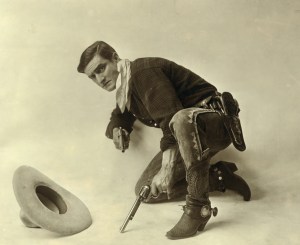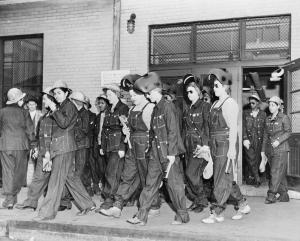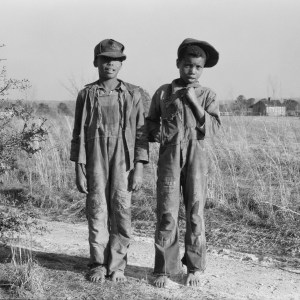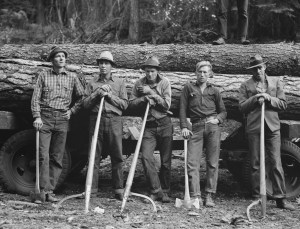 “You want to know what comes between me and my Calvins? Nothing!”–actress Brooke Shields.
“You want to know what comes between me and my Calvins? Nothing!”–actress Brooke Shields.
Ms. Shields’ seductive pose and vampish delivery in that controversial 1980 TV commercial shocked the nation. She was only 15 at the time, but her fetching gaze most assuredly earned Calvin Klein a boatload of cash.
Where would we be without our jeans, and how did they become the iconic garment that none of us, no matter what our age, race, socio-economic level, sexual orientation or BMI, can do without?
To answer those questions, filmmakers Anna Lee Strachan and Michael Bicks crafted a solidly researched script, recorded articulate commentary from notable cultural historians and fashion pros, and unearthed a fascinating collection of vintage photos, film footage and artifacts for their latest film project, Riveted: The History of Jeans. To say that you are almost certain to be riveted by Riveted is an understatement. At the very least, you will never look at a simple pair of blue jeans the same way again.
As it turns out, blue jeans played a surprising role in the history of race, work, gender equity, and class in America, from colonial era slavery through the Hip-Hop culture of the late 20th century. Although fashionistas may not find exactly what they are looking for in the film, Riveted: The History of Jeans will have a long shelf life in high school and college classrooms and library and museum programs. The film makes its timely debut during Black History Month on the PBS American Experience series tonight, Monday, February 7, 2021, 9:00 pm/ET; 8:00 pm/C. Check local listings in your region. It will also stream simultaneously with broadcast (see below for details).

Anna Lee Strachan wrote, directed and produced RIVETED: THE HISTORY OF JEANS with Michael Bicks for the PBS series, AMERICAN EXPERIENCE.
In my Q&A with Riveted writer, director, producer Anna Lee Strachan that follows (conducted via email), we explore how and why the provenance of a single garment, a staple in our 21st century lives, unlocks pivotal, untold narratives in American history.
Judith Trojan: You have an impressive background in science… a degree in Neuroscience from Harvard, a M.S. in science writing from MIT, and a career writing and producing science-related projects for NASA, NPR and the PBS NOVA series. Yet, with your production partner Michael Bicks, you wrote, produced and directed Riveted, a film about the history of jeans for American Experience! That’s quite a stretch! How did that theme spark your interest and gel with your background in science?
Anna Lee Strachan: Why in the world is a science producer making a film about fashion history? What can I say… the pandemic brought out a new angle in all of us! I suspect the root motivation behind this film and my career producing science are the same—to provide people with tools to deal with an increasingly complex world.

Hollywood’s romanticized version of the American cowboy in blue jeans began in silent films with Tom Mix, here seen hamming it up during a photo shoot, circa 1919. Photo courtesy Library of Congress.
Growing up, I was deeply frustrated by racism, prejudice and ignorance. I became convinced that one way to fight it was by revealing the beauty of science and evidence-based thinking. If I could only get people to be curious enough to consider the evidence for their beliefs, perhaps we can stand a chance against human nature’s worst impulses.
So, for me, a documentary about an iconic object we hold dear is not that different from a documentary about artificial intelligence. We all bring preconceived notions of such things to the table, and both history and science are evidence-based quests for truth.
What I hope viewers take away from this film is that even a humble pair of pants might force us to reconsider the ways we tell stories and build our identities. If we can take a more inclusive view of history, it builds a far richer picture to better engage with each other.
Trojan: Riveted is quite a revelation! Most viewers will tune in expecting a film about cowboys, hippies and the fashion industry. Instead, you not only touch on jeans fashion and pop culture through the decades but, more importantly, connect the dots to little known but pivotal aspects of race, gender equity and class in America. Of the three, which do you feel was the most transformative in the history of jeans?
Strachan: That’s a tough one. All three were certainly pivotal. If I had to pick one for simplicity’s sake, I’d go with gender equity. How denim went from work wear to fashion is nothing short of transformational. Women really took the lead here….for how, check out the film!!

Denim-clad women welders en route to their job to help the war effort, circa 1943. Photo: Stocktrek Images, Inc./Alamy Stock Photo.
Trojan: The history of race in America permeates the entire history of jeans, from colonial era slavery through the Hip-Hop culture of the late 20th century. It’s clear from the film that blue jeans predated Levi Strauss because print announcements tracking runaway slaves described their garments, which included ‘blue jeans.’ Were you aware from the outset how important African Americans were to the history of blue jeans in America?
Strachan: Not nearly to the extent that we discovered. From the outset we knew two missing pieces of the story were cotton and Indigo, the two key ingredients for making denim. What we didn’t know was just how much these stories owed to enslaved peoples, not to mention the discovery of ‘slave cloth’ or ‘negro cloth,’ a precursor to denim used to clothe the same captive people who grew the raw material and shared their generational expertise about how to dye cloth this amazing shade of blue.
Trojan: The history of Indigo growing, processing and dyeing demanded a special skillset that West Africans carried with them to American shores where they were enslaved. Can you explain why that particular dye, given how complicated it was to produce, became the definitive color of garments worn by hard laborers in the fields, forests, factories, coal mines and building trades? Why blue? Why Indigo?
Strachan: We never found a single answer for that in our research, but experts led us to suspect two possible reasons: 1) Indigo was just an amazing dye stuff for centuries—it was fast (meaning it didn’t fade over time like most dyes did), affordable, and it was incredibly good at hiding dirt. 2) People just like the color blue! It’s hard to find a culture on Earth that doesn’t associate blue with the heavens and goodness.

The history of race in America, from colonial era slavery through the Hip-Hop culture of the late 20th century, permeated the entire history of blue jeans. Photo courtesy Library of Congress.
Trojan: Eliza Lucas is relevant not only as a trailblazing female entrepreneur, but also as an example of how class and race played a key role in the success of the Indigo trade. How did she, a woman and a colonial governor’s daughter, manage to spearhead the successful planting and production of Indigo and tap into and exploit the acumen of West African slaves? How important was her reach and for how long?
Strachan: The story of Eliza Lucas is a good one. Here we have a story of a female entrepreneur credited for starting the Indigo economy in colonial America. It’s a story told in textbooks and commemorated in museums. Indeed she was a botanist in her own right, distributed Indigo seed across South Carolina, and figured out how to make the crop profitable in the region. But what is left out of the narrative is the intellectual contribution of her West African enslaved people, who almost certainly shared their generational expertise of growing Indigo, making the dye (an extremely difficult process that at the time took years of apprenticeship), and then dyeing the cloth.
Trojan: Nevada tailor Jacob Davis and California dry goods salesman Levi Strauss joined forces to create a better jean. Why is it that we know the name Levi Strauss and not Jacob Davis, when Davis brought a crucial new element–the seam strengthening copper rivet–to the partnership and the garment?

Loggers needed heavy, reinforced work pants and, once they were riveted, blue jeans fit the bill. Photo: Dorothea Lange. Courtesy Library of Congress.
Strachan: Davis went to Levi Strauss because he did not have the resources to afford the patent, let alone mass produce the garment. Since Davis later went to work for Strauss as his factory manager, it would seem he accepted from the start that Levi Strauss’s name would be out front. (As a side note, we learned that it’s often the case with invention that the name that gets associated with it is the one with funds and wherewithal to support its production, if it’s not the inventor himself or herself.)
Trojan: Throughout the film, you incorporate wonderful archival photos and film footage, vintage period illustrations and newspaper clips. Where did you do your research? Any roadblocks?
Strachan: A project like this is a huge collaborative endeavor, and I certainly couldn’t have done it without my longtime producing partner, Michael Bicks, or our brilliant editor, Brian Funck. This was our first historical film. We were very lucky to have worked with Melissa Pollard, a seasoned Archival Producer who found all of the images used in the film. There were roadblocks, in particular, finding the rights holders let alone getting their permission for many of the images and especially the music.
Trojan: How long did this project take you to complete?
Strachan: About 10 months, not counting the month to develop the pitch. We are freelancers after all, so it’s hard not to work for free at least part of the time!

He’s got jeans! President Obama practices throwing out the first pitch before the MLB All-Star Game. Photo: Official White House Photo/Pete Souza.
Trojan: Who or what period would you say was the most transformative in the history of jeans in America and their transition from quintessential workers’ garments to garments worn 24/7 by all races, ages, sexes and cultures in America?
Strachan: I would say the real democratization of fashion—in part led by jeans—really took off in the 1970s. This is really the decade where, for the first time, you could find any man, woman or child wearing denim at nearly any time or place.
Trojan: Is there a timely take-away from Riveted?
Strachan: Certainly! I can’t put it better than one of our participants, fashion historian Emma McClendon: ‘Denim and its history is a perfect metaphor for where we find ourselves as a culture right now. Becoming much more aware of the silences, of those groups that have been pushed to the side. Exposing and celebrating these narratives that haven’t made it into that typical telling of jeans is part of the work to change our understanding of American history.’ Ω
Riveted: The History of Jeans debuts on the PBS American Experience series tonight, Monday, February 7, 2021, 9:00 pm/ET; 8:00 pm/C. Check local listings for air times and repeat broadcasts in your region. The film will stream simultaneously with broadcast and be available on all station-branded PBS platforms, including http://www.pbs.org/wgbh/americanexperience/ , the PBS Video App and, for members, on PBS Passport. –Judith Trojan


Having had our toddler to HS grad aged kids – sons and daughter – hand their father their fav jeans to mend (often at the knee), we don’t get the frayed ripped knee stressed thing in fashion the last few years – we wonder why that wasn’t covered in this fantastic jeans doc? BTW – the kids preferred to find “new” jeans in clean, good, broken-in-condition at the Sally-Anne, Hospital Auxiliary, or Value Village 2nd hand thrift stores. (saved we two on teacher’s salaries a lot).
LikeLiked by 1 person
Thank you for your response to my review and interview! So glad you enjoyed the film! Although fashion trends were briefly alluded to within the context of the history of blue jeans, fashion and style through the decades were definitely not the focus of the film. As I mentioned in my review, fashionistas may not find what they’re looking for in this film. Perhaps another fine film will cover that angle in the future.
LikeLike
Very interesting!
LikeLiked by 1 person
I really enjoyed reading this piece. And like Kathy above, I will now tune in to watch this program. Thank you for highlighting a show that I might easily have overlooked.
LikeLiked by 1 person
Wonderful! It’s a fascinating film. Thank you, Peggy!
LikeLike
I heard a promo for “Riveted” on NPR this morning and made a mental note to tune in.
After reading your insightful interview, it’s definitely a must-see.
So, tonight, with a cup of herbal tea in hand, I’ll be watching this documentary about the world’s beloved garment. And, you betcha, I’ll be wearing my jeans!
Thanks for bringing your blog to your faithful readers!
LikeLiked by 1 person
Thank you, Kathy! Thanks so much for your support! I know you’ll find this film fascinating and informative!
LikeLike